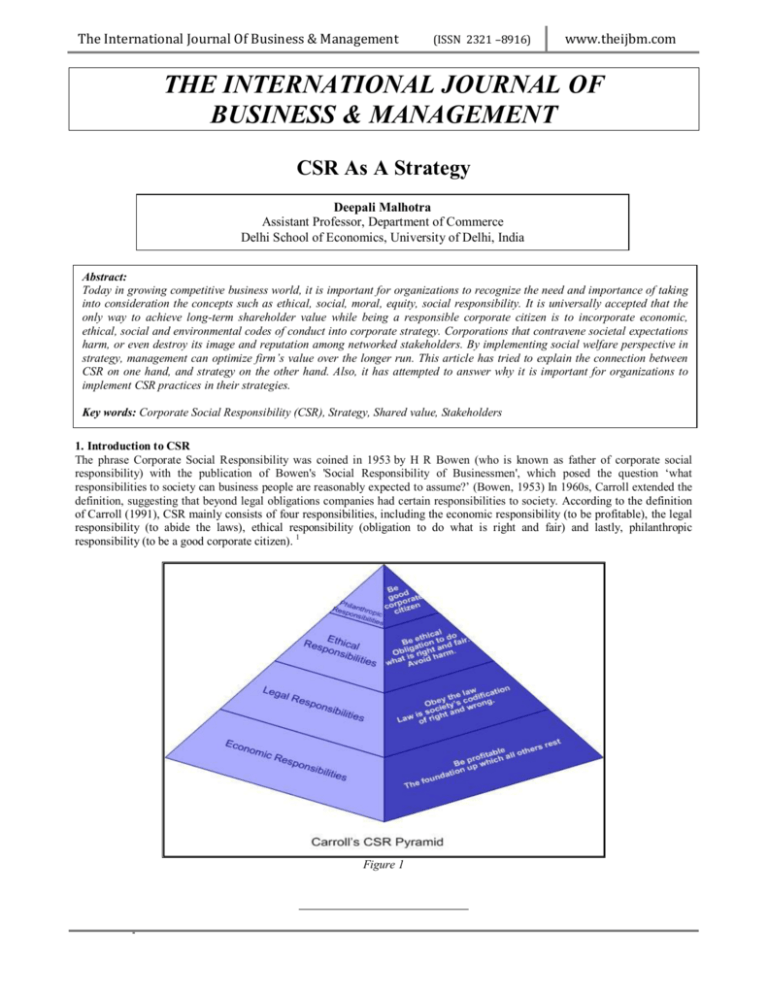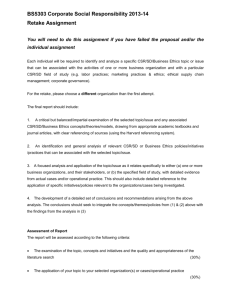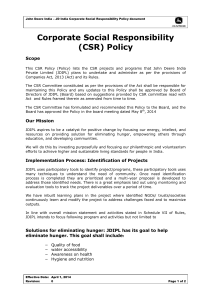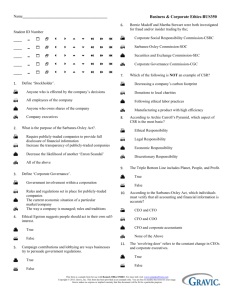- The IJBM
advertisement

The International Journal Of Business & Management (ISSN 2321 –8916) www.theijbm.com THE INTERNATIONAL JOURNAL OF BUSINESS & MANAGEMENT CSR As A Strategy Deepali Malhotra Assistant Professor, Department of Commerce Delhi School of Economics, University of Delhi, India Abstract: Today in growing competitive business world, it is important for organizations to recognize the need and importance of taking into consideration the concepts such as ethical, social, moral, equity, social responsibility. It is universally accepted that the only way to achieve long-term shareholder value while being a responsible corporate citizen is to incorporate economic, ethical, social and environmental codes of conduct into corporate strategy. Corporations that contravene societal expectations harm, or even destroy its image and reputation among networked stakeholders. By implementing social welfare perspective in strategy, management can optimize firm’s value over the longer run. This article has tried to explain the connection between CSR on one hand, and strategy on the other hand. Also, it has attempted to answer why it is important for organizations to implement CSR practices in their strategies. Key words: Corporate Social Responsibility (CSR), Strategy, Shared value, Stakeholders 1. Introduction to CSR The phrase Corporate Social Responsibility was coined in 1953 by H R Bowen (who is known as father of corporate social responsibility) with the publication of Bowen's 'Social Responsibility of Businessmen', which posed the question ‘what responsibilities to society can business people are reasonably expected to assume?’ (Bowen, 1953) In 1960s, Carroll extended the definition, suggesting that beyond legal obligations companies had certain responsibilities to society. According to the definition of Carroll (1991), CSR mainly consists of four responsibilities, including the economic responsibility (to be profitable), the legal responsibility (to abide the laws), ethical responsibility (obligation to do what is right and fair) and lastly, philanthropic responsibility (to be a good corporate citizen). 1 Figure 1 21 Vol 1 Issue 6 December, 2013 The International Journal Of Business & Management (ISSN 2321 –8916) www.theijbm.com In earlier times this concept has not received much support, but presently it is taken seriously by wide sections of society. The concept of CSR came to the forefront in the late 90s and early 2000s due to the outburst of chain of scams such as failure of Enron, Maxwell, WorldCom, Satyam, Coca-cola bottle pollution case, Adidas child labour case China’s milk poisoning case, etc. Also, with the formation of the New Companies Act 2013, this concept is gaining prominence. In present times, many corporations are undertaking diverse social activities to satisfy different types of stakeholders Most of the corporations focus on community development activities like education, health, rural development; human resource development; environmental protection activities; energy conservation activities; following codes of business ethics; child and labour welfare practices; support of local businesses or charities; providing equal opportunities to all; etc. 2. Benefits of CSR Activities to a Business Entity With rising investment by organizations in various CSR activities, the question that comes to every mind is whether this investment is worthwhile? Does it pay? Many scholars have proved that investment in CSR activities leads to enhanced brand image and reputation, increased sales and customer loyalty, increased productivity and quality which leads to improved financial performance. Most of the researchers have focussed on stakeholders’ theory to show the benefits of CSR activities in commercial businesses. According to stakeholder theorists, “there is a high correlation between good management practice and Corporate Social Performance (CSP) because attention to CSP domains improves relationships with key stakeholder groups, resulting in better overall performance. For example good employee (including women and minorities) relations might be expected to enhance morale, productivity and satisfaction. Excellent community relations might provide incentive for local government to provide competition-enhancing tax breaks, improved schools or reduce regulation, thereby reducing costs to the firm and improving the bottom line.” (Waddock and Graves, 1997) CSR (Corporate social responsibilit Satisfaction of Stakeholders’ needs Shareholders, employees, suppliers, customers, government, investors, Political Improved relationship with satisfied Stakeholders CFP (corporate financial performance Figure 2: Stakeholders’ Theory The proponents for a positive relationship between CSR and CFP view that the benefits of being engaged in CSR are more than the costs involved. They suggest that “firms have different classes of internal and external stakeholders and in order to satisfy their social demands and avoid their negative confrontations like boycotts, complaints, objections, and protests its firms have to consider social commitments while taking their decisions” (Ehsan and Kaleem, 2012). According to Freeman (1984), in the perspective of stakeholder theory, firms’ responsibility is not only to satisfy the shareholders but to satisfy all types of firm’s stakeholders. Thus, the liability of an organization’s management extends beyond the profitability and they must include social issues in their decisions. Also, “government cannot solve all social issues with scare resources alone and it needs private-public partnership to address the social development issues” (Makki et al., 2008). Moreover, according to Kang et al., (2009), firms which are involved in illegal, unethical and irresponsible activities suffer huge financial crisis as these activities are adverse for social wellbeing. Most importantly, “commitment to CSR would result in increased costs to competitiveness and decrease the hidden costs of stakeholders” (Yang et al., 2009). “This argument is meaningful and reasonable, as good relationships with employees, suppliers, and customers are necessary for the survival of a company” (Bolante et al., 2012). Bowman and Haire (1975) perceive CSR as a management skill or as a representative of reputation. When a company spends on social issues, its reputation will enhance which will have positive impact on its sales. Therefore, when a company increases its costs by improving CSP in order to increase competitive advantages, such CSR activities can enhance company reputation, thus, in the long run CFP can be improved, by sacrificing the short term CFP. In addition, “CSR increases customer satisfaction, which in turn leads to positive financial returns as it helps promote external social benefits, such as public goodwill outside the firm, which can polish its reputation in the presence of corporate scandals or regulatory scrutiny” (Luo and Bhattacharya, 2006). Moreover, firm possessing good reputation in CSR can boost internal employee morale and commitment within the firm and also is in position to recruit better employees which may enhance its productivity along with lowering costs thereby improving its financial performance. (Godfrey, 2005; Luo and Bhattacharya, 2006) “Firms are contributing in the social wellbeing of society, improving the living standards by promoting education and better health facilities, protecting environment from hazardous changes. They are also taking good care of their employees in order to build their trust and confidence. In turn these social expenditures not only facilitate the firms to attain the continuous and long term sustainable development but also help them to achieve financial benefits as well” (Ehsan and Kaleem, 2012). 22 Vol 1 Issue 6 December, 2013 The International Journal Of Business & Management (ISSN 2321 –8916) www.theijbm.com 3. What is Strategy According to military science, strategy is the science and art of general to win at war. It is an ancient technique of fighting with enemies in different terrains, territories or areas. Any technique to win a war requires planning. “Strategy,” wrote von Clausewitz (1982, p. 4), “makes the plans for the separate campaigns and regulates the combats to be fought in each.” Similar military definitions of strategy date as far back as Sun Tzu’s The Art of War and the Greek writings on the institution of the strategos (Cummings, 1993). Modern definitions of strategy involve formulating plans to compete successfully in business. According to Chandler (1962, p. 13), “Strategy is the determination of the long-run goals and objectives of an enterprise, and the adoption of a course of action and the allocation of the resources necessary for carrying out these goals.” Glueck (1980) define strategy as, “A unified, comprehensive, and integrated plan designed to assume that the basic objectives of the enterprise are achieved.” Thus we can say that strategy is long-term which requires establishing specific goals, formulation of a plan, and commitment of resources to achieve sustainable competitive advantage and superior performance. 4. Why Every Corporation Needs a CSR Strategy There is a strong and enduring connection between CSR and Strategy. CSR is significant for corporations as businesses are built on trust, faith and prudence. Establishing faith with consumers, suppliers, communities, and other stakeholders is not an easy task and it can easily be damaged. In order to be successful in the long-run, organizations are required to think beyond profitability. They are also required to take into consideration alterations in social, environmental and governance issues. Role of the stakeholders is central to strategic view to CSR (Galbreath, 2008; Hildebrand & Sen, 2011), therefore large number of corporations are analyzing its CSR in terms of interests of numerous and varied stakeholders. The concept of Corporate Social Responsibility lies around the idea of building ‘shared value’ (value for the corporation and for the society). “The role of business is to create value for its shareholders but in such way that it also creates value for society, manifesting itself as a win-win proposition”. The concept depends on the ability of corporation to create value for itself, which in turn creates value for society. Following are some of the examples of companies which have focused on ‘shared value’ principle: Adidas Group Adidas has aligned with Grameen Bank to manufacture cheap and affordable shoes for the poor people in Bangladesh, besides the shoes will also protect them from diseases. BMW Establishment of a mobile BMW Guggenheim Lab that will travel to nine major cities throughout the world over a particular period of years to address issues of modern urban life through programs and public discussion in the areas of architecture, art, design, science, technology, education, and sustainability. Heinz Launch of a cost effective “micronutrient campaign” by Heinz to reduce the threat of iron-deficiency anemia and vitamin and mineral malnutrition among infants and children in the developing world. Cisco Establishment of Cisco Academics by Cisco to train networking personnel. Apart from these, companies like Google, IBM, Intel, Johnson & Johnson, Nestlé, Unilever, and Wal-Mart all have initiated with ‘shared value’ initiatives. With the increasing role of CSR, the question for organization is not whether to invest in CSR activities, but to find out the way to formulate best CSR strategy that would reflect its business values as well as social values. Organizations took up CSR activities due to various motivators underlying the various initiatives. Some of the motivators are increasing sales and profitability; employee recruitment, motivation and retention; brand building and reputation management; risk management; Competitiveness and market positioning; legal compliance; customer satisfaction etc. Brand image is very important for an organization as its sales and profitability depends on it and it helps organization to achieve competitive advantage. Following are some of the examples of companies that have achieved competitive advantage because of its CSR initiatives: Times of India ‘Lead India Campaign’ was launched by Time of India to bring about change in society. This campaign created a positive reputation in mind of public and helped in building its good brand image. NIKE After learning from the past mistakes when Nike was attacked by various NGOs in mid 1990s, it emerged as growing corporation in terms of CSR. It was the first organization to have Vice-President for Corporate Responsibility and to publish an annual CSR Report which helped it achieve competitive advantage. Almost all leading companies are involved in some of the CSR initiatives in areas like education, health, employment generation, HR development, and empowerment of weaker sections of the society, etc. Some of the companies are as follows: ITC ITC launch of ‘e-Choupal program’ for rural digital infrastructure ‘Social and Farm Forestry initiative’ benefitted over 4 million farmers and created a huge employment. It also established Watershed Development initiative to carry water to over 46,000 hectares of dry lands and moisture-strained areas. It is the first company in India to be certified to the SA 8000 social Accountability standard. Microsoft: Launch of Rozgar/ Kshamta‘ programs helped in creating employable workforce in the country. 23 Vol 1 Issue 6 December, 2013 The International Journal Of Business & Management (ISSN 2321 –8916) www.theijbm.com Indian Oil Corporation donates 0.75% of net profit for community development. Larsen and Toubro One of the first company to launch an HIV/AIDS programme. Aditya Birla Group Aditya Birla Group had also taken various initiatives in area of education, health, infrastructure development for rural Development. BHEL All BHEL units are certified to the ISO14001 environmental management system. Tata Iron and Steel First Indian company to publish a sustainability report in line with Global Reporting Initiative guidelines. Therefore it is important for forward-thinking corporations to incorporate these CSR activities as a part of business strategy to maximize what Porter and Kramer (2011) have called “shared values”. According to Wilson (2000), “strategy has a much broader role: it should take a holistic approach to shaping the future of the corporation in its entirely, mapping out what we want the organization to become, and how we plan to get there.” The strategy of an organization should focus not only on “hard” goals such as market share, competitive success, financial goals, maximizing shareholders’ value, etc. but also on “soft” factors such as social responsibility, organizational culture, etc. Husted and Allen (1998, p. 9) Defines the concept of corporate social strategy as, “the firm’s plan to allocate resources in order to achieve long-term social objectives and create a competitive advantage.” Firms are required to create value for the firm through its social, ethical and environmental programs. The basic problem with CSR practices is that corporations do not have a CSR strategy rather they have a range of diverse CSR procedures and Initiatives. According to Wilson (2000), there is a set of ‘new rules’ that occur as a result of globalization, that describe the nature and character of emerging societal expectations. Thus, it is imperative that every organization should have a suitable CSR strategy that unites the numerous disparate CSR initiatives under one roof. Also, a proper balance should be maintained between the hard and soft goals. CSR is required to be established within the core values of the organization and it must be connected to the mission, vision, goals, objectives and values of the firm. ^ Legitimacy. To earn and retain social legitimacy, the corporation must define its basic mission in terms of the social purpose it is designed to serve rather than as the maximization of profit. ^ Governance. The corporation must be thought of, managed, and governed more as a community of stakeholders and less as the property of investors. ^ Equity. The corporation must strive to achieve greater perceived fairness in the distribution of economic wealth and in its treatment of all stakeholder interests. ^ Environment. The corporation must integrate the practices of restorative economics and sustainable development into the mainstream of its business strategy. ^ Employment. The corporation must rewrite the social contract of work to reflect the values of the new workforce and increase both the effectiveness and loyalty of employees and the corporation. ^ Public-private sector relationships. To ensure the success of the power shift, corporations must work closely with governments to achieve a viable and publicly accepted redefinition of the roles and responsibilities of the public and private sectors. ^ Ethics. The corporation must elevate and monitor the level of ethical performance in all its operations in order to build the trust that is the foundation of sound relationships with all stakeholder groups. Figure 3: The New Rules of Corporate Conduct Source: Wilson (2000) 5. Conclusion As can be seen from the various examples cited above, a large number of corporations are undertaking CSR activities. CSR was initially used as a tactic to calm down consumers’ ethical and social concerns. Many scholars have proved positive impact of CSR activities on organizations’ financial performance. With its growing importance, CSR has shifted from ‘doing Good’ To Essential Sphere Of Business Strategy. The Major Challenge Organizations Are Facing while formulating strategy is how to detect and respond to the new rules of the game which are determined by rapidly changing industry, basis for competition, market structure and societal expectations of corporate social performance. Therefore, it is essential for an organization to incorporate their social, ethical and environmental initiatives in their strategy to achieve ‘shared value’. 6. Scope for Further Research Work This article has primarily focused on the conceptual part of using CSR as a strategy by relating it with some of the companies that have effectively used it. However, it would be interesting to know further how a corporation can build or formulate a proper CSR strategy and to empirically find out the impact of using CSR strategy on company’s performance. Further research can also be done to determine whether it is ethical to use CSR as a strategy or not. 24 Vol 1 Issue 6 December, 2013 The International Journal Of Business & Management (ISSN 2321 –8916) www.theijbm.com 7. References 1. Bolanle, A., Olanrewaju, A. & Muyideen, A. (2012). Corporate Social Responsibility and Profitability of Nigeria Banks A Causal Relationship. Research Journal of Finance and Accounting, 3(1). ISSN 2222-1697 (Paper) ISSN 2222-2847 (Online). 2. Bowman, E.H & Haire, M. (1975). A strategic posture toward corporate social responsibility. California Management Review, 18(2), 49–58. 3. Bowen, H.R. (1953). Social Responsibilities of the Businessman. New York: Harper. 4. Carroll, A.B. (1991). The pyramid of corporate social responsibility: toward the moral management of organizational stakeholders. Business Horizons, 34, 39-48. 5. Chandler, A.: (1962) Strategy and Structure: Chapters in the History of American Industrial Enterprise (MIT Press, Cambridge, MA). 6. Cummings, S. (1993). Brief Case: The First Strategists. Long Range Planning 18, 133–135. 7. Ehsan, S. & Kaleem, A. (2012). An Empirical investigation of the relationship between Corporate Social Responsibility and Financial Performance (Evidence from Manufacturing Sector of Pakistan). J. Basic. Appl. Sci. Res., 2(3), 2909-2922. 8. Freeman, R.E., Strategic management: A stakeholder approach (Pitman, Boston). 1984. 9. Glueck, W F (1980) Business Policy and Strategic Management, New York: McGraw Hill. 10. Hildebrand, D., Sen, S. & Bhattacharya, C.B. (2011). Corporate social responsibility: a corporate marketing perspective. European Journal of Marketing, Vol. 45 Iss: 9/10, pp.1353 – 1364. 11. Husted, B. W. & Allen, D. B. (1998). Corporate Social Strategy: Toward a Strategic Approach to Social Issues in Management. paper presented at the Academy of Management meetings, San Diego, California. 12. J Ian Wilson, (2000). The new rules:: ethics, social responsibility and strategy, Strategy & Leadership, Vol. 28 Iss: 3, pp.12 – 16 13. Kang, K.H., S. Lee, & Huh, C. (2009) Impacts of positive and negative corporate social responsibility activities on company performance in the hospitality industry. International Journal of Hospitality Management, 29(1), 72-82. 14. Luo, X. & Bhattacharya, C.B. (2006). Corporate social responsibility, customer satisfaction, and market value. Journal of marketing, 70(4), 1-18. 15. Makki, M.A.M. & Lodhi, S.A. (2008). Determinants of corporate philanthropy in Pakistan. Pakistan Journal of Commerce and Social Sciences, 1, 17-24. 16. Prachi Arora (2013). Incorporate Corporate Social Responsibility Strategy into Business. The SIJ Transactions on Industrial, Financial & Business Management (IFBM), The Standard International Journals (The SIJ), Vol. 1, No. 2, Pp. 75-82.Von Clausewitz, K.: 1982, On War (Penguin, London). 17. Waddock, S.A. & Graves, S.B. (1997). The Corporate Social Performance-financial Performance Link. Strategic Management Journal, 18(4), 303–319 25 Vol 1 Issue 6 December, 2013







